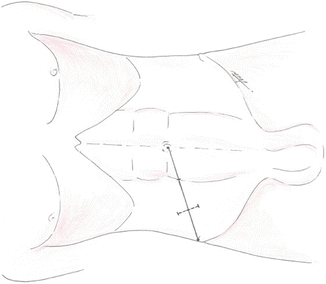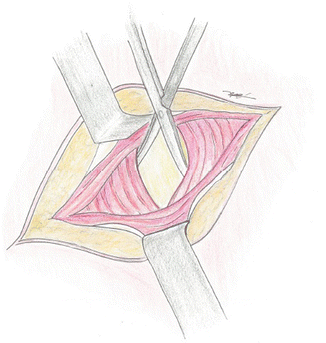, Marco Lotti2 , Michele Pisano3 and Elia Poiasina4
(1)
General Surgery I, Department of Emergency, Papa Giovanni XXIII Hospital, Bergamo, Italy
(2)
General Surgery 1 Unit, Centre for Mini-invasive Surgery, Ospedali Riuniti di Bergamo, Bergamo, Italy
(3)
General Surgery 1 Unit, Department of Emergency, Centre for Mini-invasive Surgery, Ospedali Riuniti di Bergamo, Bergamo, Italy
(4)
1st General Surgery Unit, Department of Emergency, Papa Giovanni XXIII Hospital, Bergamo, Italy
18.1 Appendectomy
18.2 Open Appendectomy
18.2.1 Positioning and Personnel
18.2.2 Exploration
18.2.5 Drainage
18.2.6 Abdominal Closure
18.2.7 Variations
18.4.1 Equipment and Instruments
18.4.3 Port Site Placement
18.4.4 Exploration
18.4.6 Appendectomy
18.4.7 Drainage (As Above)
18.4.8 Retrocecal Appendicitis
18.4.9 Pelvic Abscess
18.4.10 Retrograde Appendectomy
18.4.11 Normal Appendix
18.4.12 Conversion
18.1 Appendectomy
Objectives: To Describe
The most common technique
Technique for ectopic (retrocecal) appendicitis
Management of pelvic abscesses and peritonitis
Indications for conversion
Open questions: treatment of the appendicular stump, drainage, optimal port sites, treatment of associated Meckel’s diverticulum, resection of a normal appendix
18.2 Open Appendectomy
18.2.1 Positioning and Personnel
The patient is placed supine and right arm tucked to the patient’s side.
Urinary catheter insertion is optional (may be omitted if the patient has voided immediately before anesthesia).
The surgeon stands to the right of the patient, the assistant on the left, and if available scrub nurse (second assistant) on right, close to the legs.
Draping:
Should allow extension of the incision (right iliac fossa or midline) as well as insertion of drain (laterally)
Skin protection.
Adhesive skin protector is ideal but not mandatory.
Antibiotic prophylaxis.
As per local protocol
Access to the abdominal cavity
2–5 cm skin incision over McBurney’s point, perpendicular to the line between the right anterior superior iliac spine and the umbilicus (junction one-third lateral, two-third from the umbilicus (Fig. 18.1))

Fig. 18.1
Skin incision at the McBurney point
Some authors prefer a shorter incision, parallel to Langer’s lines, located two fingerbreadths medial to the anterosuperior iliac spine.
Muscle splitting
The external oblique fascia is sharply incised lateral to the rectus sheath according to the direction of its fibers.
The internal oblique and the transversus abdominis muscles are bluntly separated, according to the direction of their fibers (Fig. 18.2).

Fig. 18.2
Blunt separation of the muscle fibers
Opening the peritoneum
The peritoneum is grasped with forceps (caution being exercised not to pinch internal organs); a small incision is performed with scissors and then enlarged with finger guidance.
Retractors (handheld or autostatic) are placed.
18.2.2 Exploration
Withdrawal of free fluid for bacterial identification.
The wound is protected with moist gauze.
The appendix is located, following the taenia coli toward the cecal base.
Adhesions can usually be freed with blunt dissection.
The cecum and the appendix are then exteriorized.
18.2.3 Mesoappendix Division and Appendectomy
Division of the mesoappendix near the base of the appendix, either between clamps and ligation, or directly ligated with 2-0 absorbable suture
Placement of two wide jaw clamps parallel to each other at the appendicular base
Removal of the clamp close to the cecum
Double ligation of the base of the appendix with 0 absorbable suture (Fig. 18.3)

Fig. 18.3
Ligation of the appendix base
Division of the appendix with scalpel
Treatment of the stump
Several possibilities:
Some electrocoagulate the mucosa.
Others consider that this is dangerous and prefer to strip it with a scalpel or use bipolar cautery.
Still others prefer to invert the stump using a 3-0 absorbable purse string suture (but there is no evidence to show that this prevents secondary blowout)
Any pus or blood collection is aspirated.
Irrigate only when needed, to reduce the risk of abdominal abscess.
Aspiration of fluid in the pelvis is advisable to avoid early postoperative development of fluid collections/abscesses.
18.2.4 Search for Meckel’s Diverticulum
Resection of an uninflamed Meckel’s diverticulum should be avoided in case of appendicitis complicated with peritoneal abscess or peritonitis (see chapter on small intestinal pathology for more details).
The decision for resection of an incidental Meckel’s diverticulum should be discussed with the patient before the operation and informed consent obtained.
18.2.5 Drainage
Drainage is unnecessary in case of limited phlegmonous or gangrenous appendicitis.
In case of abscess or peritonitis, the utility of drainage is controversial type; open or closed may be used.
18.2.6 Abdominal Closure
The peritoneum is grasped with four clamps and closed with 2-0 absorbable running suture.
The transverse and the internal oblique muscles are approximated with two 2-0 absorbable stitches (figure of eight stitches should be avoided to limit muscle ischemia).
The external oblique fascia is grasped with four clamps and then closed with 0 absorbable running suture.
The skin is closed with interrupted sutures.
The incision may be left open in case of frank contamination.
Stay updated, free articles. Join our Telegram channel

Full access? Get Clinical Tree







